Arbelos
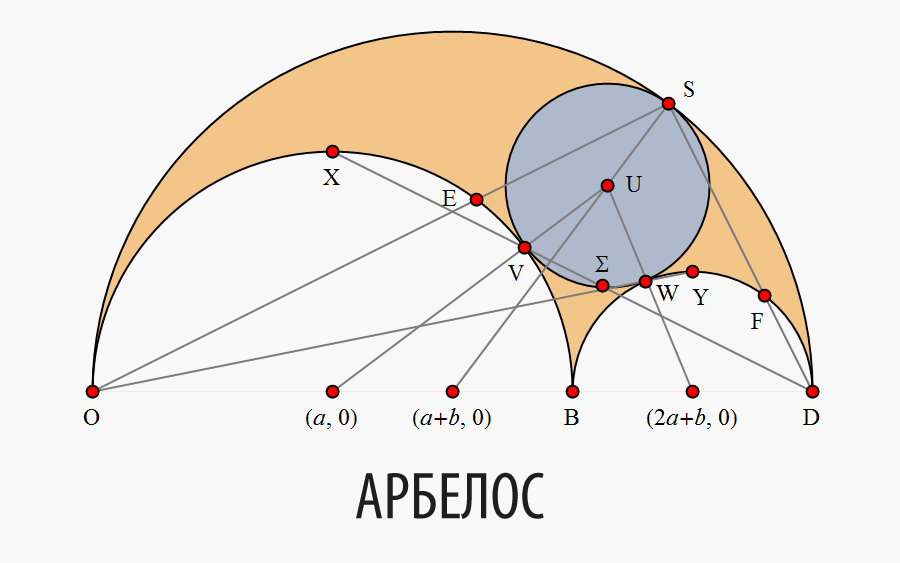
Download the article as a Mathematica document (NB) , CDF file or PDF .
I express my deep gratitude to Kirill Guzenko for his help in translating.
This article systematically checks some properties of a figure known since ancient times, called Arbelos . It includes several new discoveries and generalizations presented by the author of this work.
Introduction
Being motivated by the computational advantages that Mathematica has, some time ago I decided to start researching the properties of arbelos, a very interesting geometric figure. Since then, I have been impressed with the large number of amazing discoveries and computational problems that have arisen because of the ever-expanding amount of literature relating to this remarkable object. I recall its resemblance to the lower part of the penny-farthing cult bike from The Prisoner (1960s TV series), the Punch and Judy jesterly hat and the Yin-Yang symbol with one inverted arc; see fig. 1. Currently there is a specialized catalog of Archimedean circles (circles contained in Arbelos) [1] and important applications of the properties of Arbelos that lie outside the field of mathematics and computational sciences [2].
Many well-known researchers were engaged in this topic, including Archimedes (killed by a Roman soldier in 212 BC), Papp (320 AD), Christian O. Mor (1835-1918), Victor Tebo ( 1882-1960), Leon Bancoff (1908-1997), Martin Gardner (1914-2010). For quite some time now, Clayton Dodge, Peter Ay. Wu, Thomas Schoch, Hiroshi Okumura, Masayuki Watanabe and others.
')
Leon Bancoff is a man who has attracted widespread attention to arbelos in the past 30 years. Schokh attracted the attention of Bancoff to Arbelos in 1979, opening several new Archimedean circles. He sent a 20-page manuscript to Martin Gardner, who sent it to Banckoff, who then sent a 10-page fragment of a copy of the manuscript to Dodge in 1996. Due to the death of Benkoff, the planned collaboration was interrupted until Dodge reported on some new discoveries [3]. In 1999, Dodge said that it would take him from five to ten years to sort out all the material he has, putting the whole thing into pieces. This work is still ongoing. Not surprisingly, in the fourth volume of The Art of Computer Programming , it is said that important work requires a lot of time.

Fig. 1. Penny-farthing bicycle, Punch and Judy dolls, physical arbelos.
Arbelos (“shoemaker's knife” in Greek) is so named because of its similarity to the blade used by shoemakers (Fig. 1). Arbelos is a flat region bounded by three semi-circles and a common base line (Fig. 2). Archimedes was probably the first to start studying the mathematical properties of Arbelos. These properties are described in theorems 4 through 8 of his book Liber assumptorum (or the Book of Lemmas ). Perhaps this work was not written by Archimedes. Doubts appeared after a translation from the Arabic Book of Lemmas , in which Archimedes is mentioned repeatedly, but nothing is said about his authorship (however, there is an opinion that this book is a fake [4]). The book of Lemmas also contains the famous Archimedean Problema Bovinum [5].
This article is aimed at the systematic presentation of some properties of Arbelos and is not exhaustive. Our goal is to develop a uniform computational methodology in order to present these properties in the format of a training article. All properties are built within a certain sequence and presented with evidence. These proofs were implemented by testing equivalent calculated statements. In the course of this work, the author made several discoveries and made several generalizations.
We call the largest semicircle the upper arc , and the two smaller ones, the left-sided and right-sided arcs , or simply the side arcs , if there is no need to distinguish them. We use
This function sets arbelos.

So you can draw Arbelos himself.


Figure 2. Arbelos.
Property 1
The perimeter of the arbelos is equal to the perimeter of the largest circle.
Property 2
The area of arbelos is equal to the area of a circle with a diameter
This is lemma number 4 of the Book of Lemmas (Fig. 3) [7, 8].
These two properties are easily proved by calculating the following logical construction, consisting of two equalities.

The drawpoints function displays the set points in red circles.


Fig. 3. The area of the circle diameter
Radical circle
Circle on ris. 3 is called the radical circle of arbelos, and the line
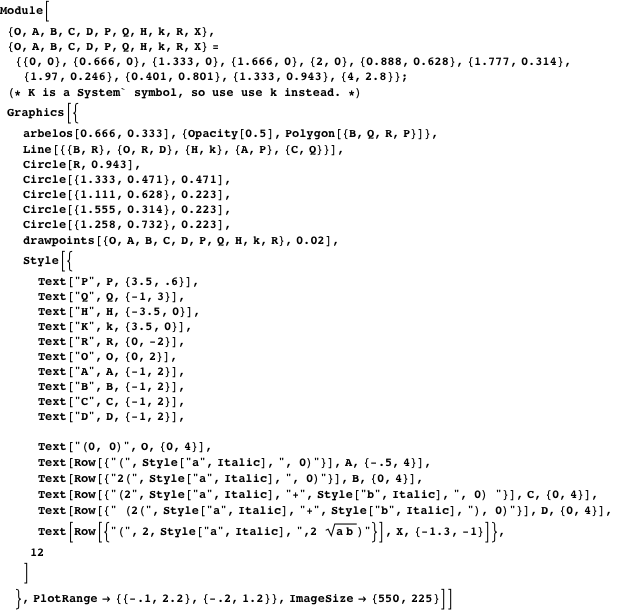

Fig. 4. Designations of coordinates, lines and circles mentioned in properties 3-11 and 25-26.
Property 3
Lines
To prove perpendicular lines

Use the obtained result to obtain the angle of the straight line
Theorem 1
The equation of the tangent to the left arc at the point
and the equation is tangent to the right arc at the point
The PQ function finds the coordinates of the touch points.
In addition to PQ , this article also includes the following notation for points and quantities: VWS , HK , U , EF , IJr, and LM .
The dSq function calculates the square of the distance between two given points.

Property 4
Points
Because

Property 5
Let line
We get the coordinates of the points


This proves property 5 by checking that the distances from
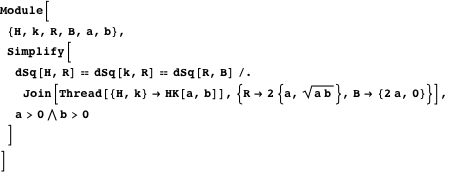
Property 6
Straight
This is equivalent to the fact that the determinant of vectors

Property 7
Straight
This is equivalent to the scalar product of vectors

Denote the circle centered at
Property 8
Couples
Back point to point
So you can prove property 8 by substituting

Property 9
Investigate the circle of reverse points
Property 10
Straight lines
This statement is analogous to the fact that the corresponding arcs (that is, their tangent) are perpendicular to the radical circle (its tangent at the intersection points). According to property 8 , arcs are perpendicular to a circle with a diameter
Property 11
This is one of the surprises of Bankoff's surprises [12,13,14]. If all four points lie on a radical circle, it suffices to prove that

The following slider demonstration (implemented through the Manipulate function) illustrates properties 3-11. The easiest way to specify the points P , Q , H , K is to copy and paste the corresponding formulas for them.
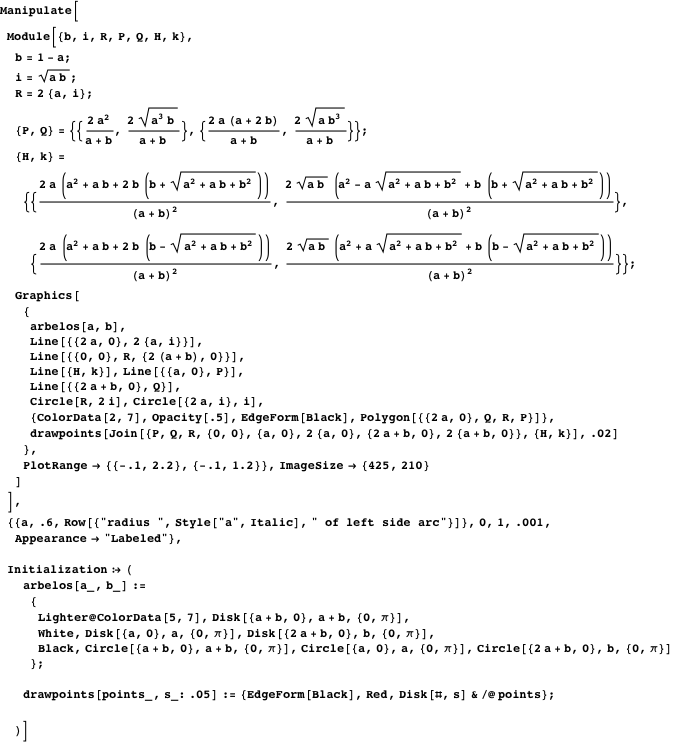
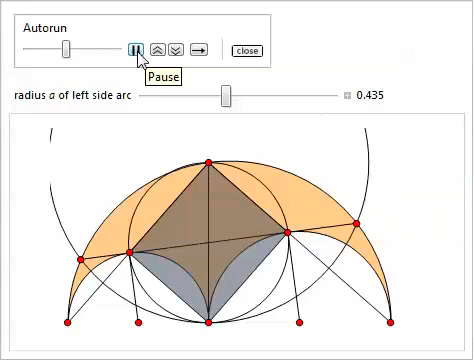
Inscribed circle
Now consider the circle tangent to the side arcs and the top arc - the inscribed circle

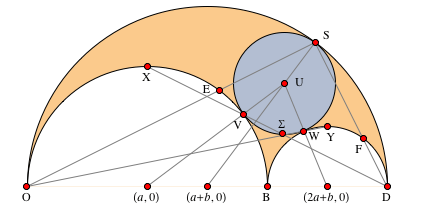
Fig. 5. The inscribed circle
The sixth statement from the Book of Lemmas also includes the radius of the inscribed circle, denoted as

Coordinates of touch points

Property 12
Points
The first two statements can be proved using the criterion of the determinant to check collinearity.

Let be

Property 13
Points


The following demo with Manipulate illustrates property 13 [17]. The Bankoff circle option will show the inscribed circle in the triangle that connects the centers of the arcs. This illustrates property 23.

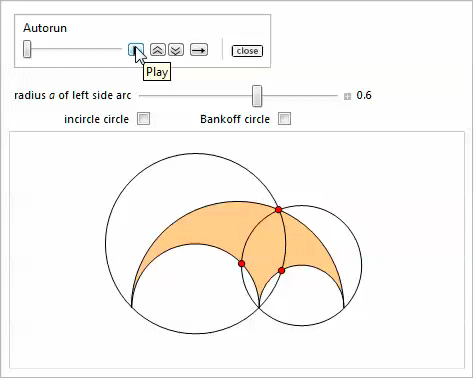
Property 14
Let be
This property is illustrated in the following demonstration with Manipulate and can be easily tested with the following expression.

Property 15
Let be
First get the points

We prove property 15 by making

Considering


A demo with Manipulate illustrates properties 14 and 15.
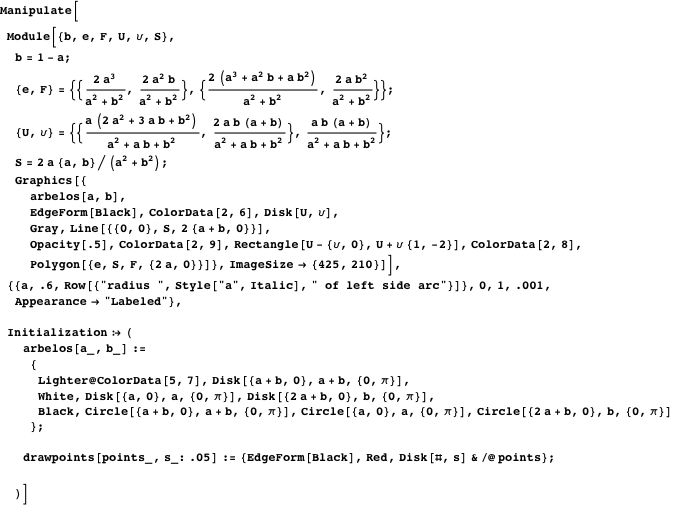

Twins
Consider two gray circles that touch the radical axis, as well as the side and top arcs in fig. 6. They are called twins , or Archimedean circles . In connection with the following remarkable property, they have been well studied. Many of their unusual features were highlighted in our property list [3, 18, 19].

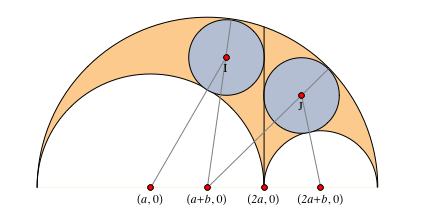
Fig. 6. Twins.
Property 16
Two circles that are tangent to the radical axis, the upper and side arcs of Arbelos, have the same radius.
This property goes as the fifth statement in the Book of Lemmas . Solving this system of six equations, we find the values of their radii, check that they are equal and find the coordinates of their centers.

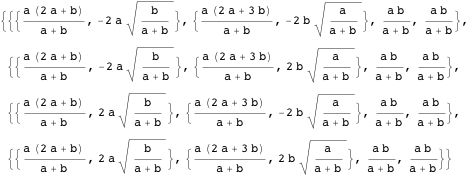
These four solutions give centers grouped in pairs:
Property 17
The area of arbelos is equal to the area of the smallest circle that covers the twins.
Consider a circle tangent to both twins, centered at

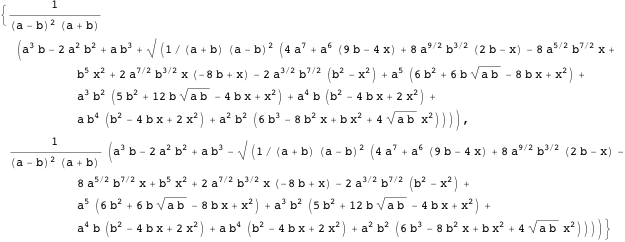
To find the extremum for
Thus, the centers of the smallest and largest circles tangent to the twins lie on the radical axis. Moreover, their centers lie at one point, which follows from the solution of this expression.

Thus, using property 2, we prove that the greatest tangent circle, which is the smallest of those containing twins, satisfies property 17. The following demonstration with Manipulate shows circles tangent to twins, while you can adjust the radius
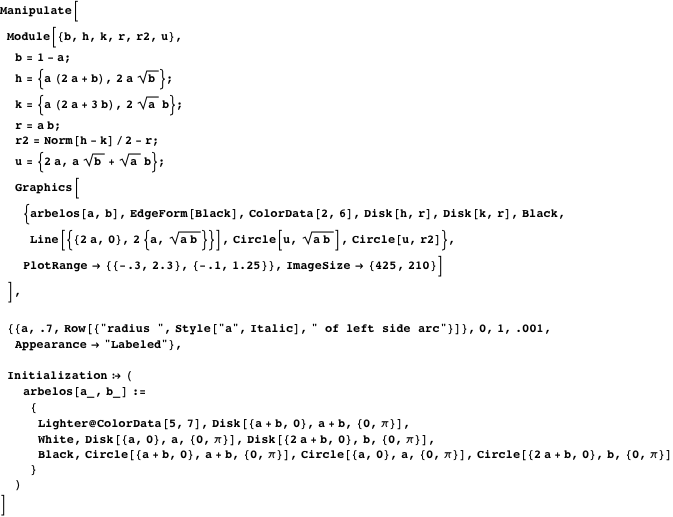

The following graph compares the radii of two circles tangent to the twins with the centers on the radical axis.
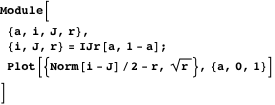
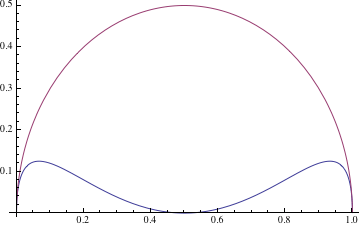
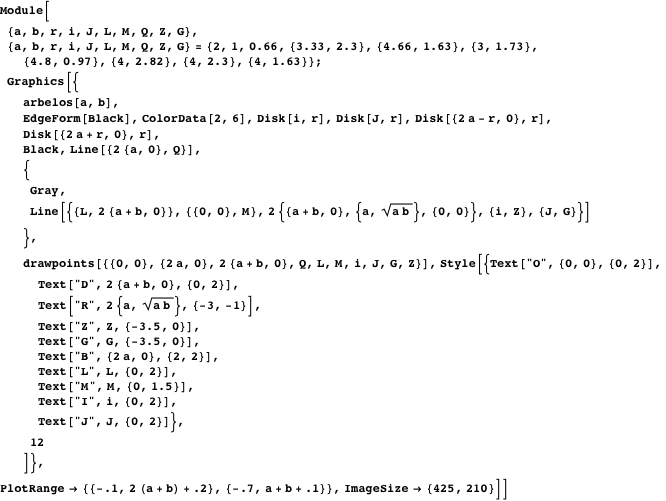
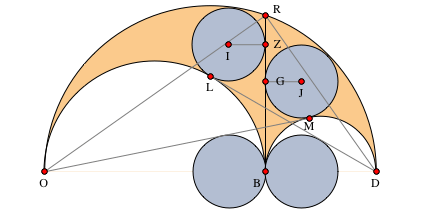
Fig. 7. Designations of points and segments, which will appear in properties 18-24.
Property 18
The common tangent to the left arc and the twin (the touch point is
So you can calculate the touch points
Using Theorem 1, we prove both statements.

Property 19
Length
We prove both statements at the same time.

However, the points
Property 20
Line
Since the length of the segment

Property 21
Two blue circles with diameters on
These circles are the fourth and fifth Archimedean circles, opened by Bancoff [20]. To check this property, use the following result [21]:
Theorem 2
Distance from point

This oriented distance will be positive if the triangle
Let be
Similarly, you can calculate the radius of the blue circle to the right of

Thus, both circles are Archimedean, as was said earlier. The next demo with Manipulate contains twins and two other circles.
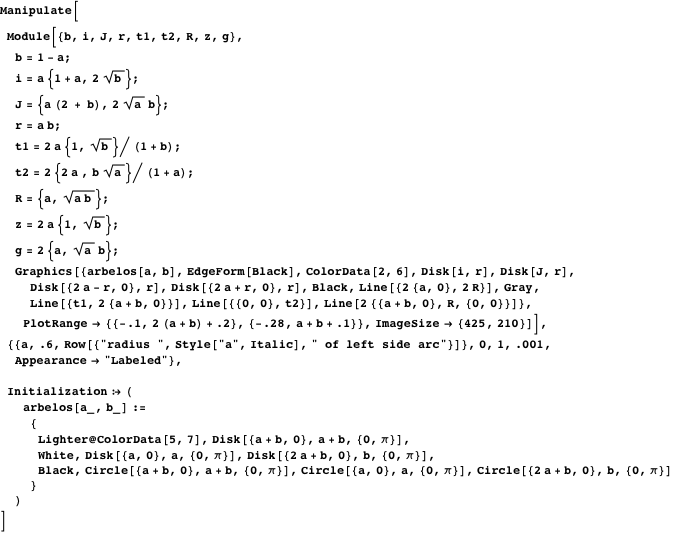

Property 22
Circle passing through points
Archimedes discovered the original two twins; Bankoff added them with a third circle, opened in 1950 [22]. Center coordinates

Property 23
Bancoff circle - inscribed in a triangle, which is formed by connecting the centers of the side arcs and the center
Using Theorem 2 to calculate the distance from

Property 24
Circle
Thus it is possible to calculate the values


Circle


Property 25
Circumference
Property 26
Circle
Circle with center at point
Since the circle passes through
Since the circle
Here we use explicit expressions for

Property 27
Consider two segments (marked in red) connecting the center of the upper arc with the vertices of the left
This property was discovered in the summer of 1998 [23].

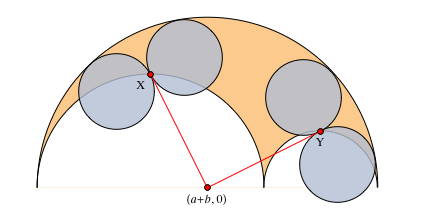
Fig. 8. Two pairs of Archimedean circles from property 27.
Inclined twins
It was shown that there are Archimedean circles distinct from the twins, namely, the Benckoff circles, which appear in properties 21-27. There are also non-Archimedean twins - pairs of circles with the same radius, different from the radius of the twins, which appear in certain areas of arbelos.
The discovery of inclined twins arose from the assumption that in addition to touching the side and top arcs, the twin circles can touch each other, and it is not necessary to touch the radical axis.
Obviously, there are an infinite number of solutions if we do not require that these circles be of the same radius. The idea was as follows: if we start with the assumption that they are of equal radius, we might as a result find that they touch the radical axis. It turned out to be wrong. Consider circles with centers at points.
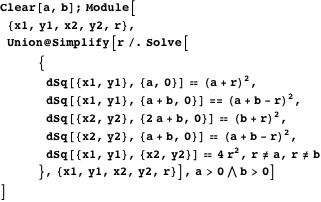

These expressions include square roots that differ in sign. Positive roots diverge by

The rest - converge.

To sum up: the inclined twins are really equal and their total radius

The following comparison between the radii of ordinary and oblique twins shows that they differ very little.

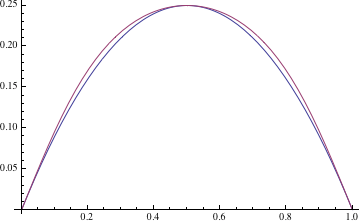
So you can get the coordinates of the centers of the inclined twins.


The following demonstration with Manipulate shows oblique twins and, optionally, twins, which are obtained by changing the parameter


Generalizations
In this section, we generalize the geometry of Arbelos, allowing the arcs to intersect and considering the three-dimensional version. To set the context of the first of the generalizations, we introduce the concept of a radical axis for two circles .
Radical axis
Let be
.
Manipulate ,

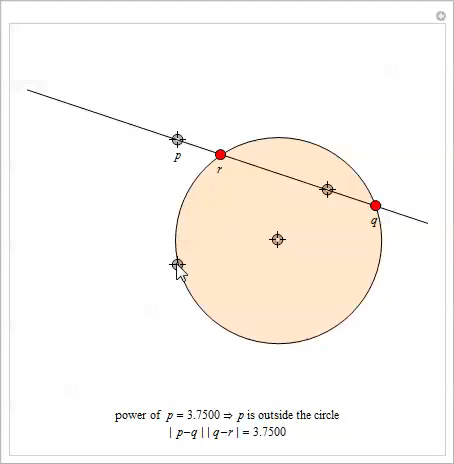
. , , . [10].
3
1
, . .
4
, .
Manipulate ; , , , . 4.

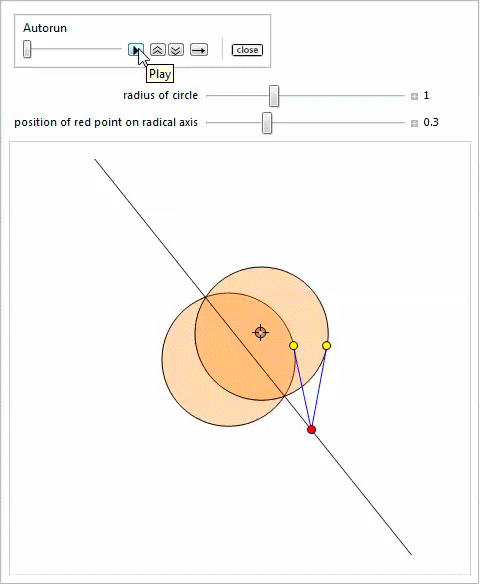
.
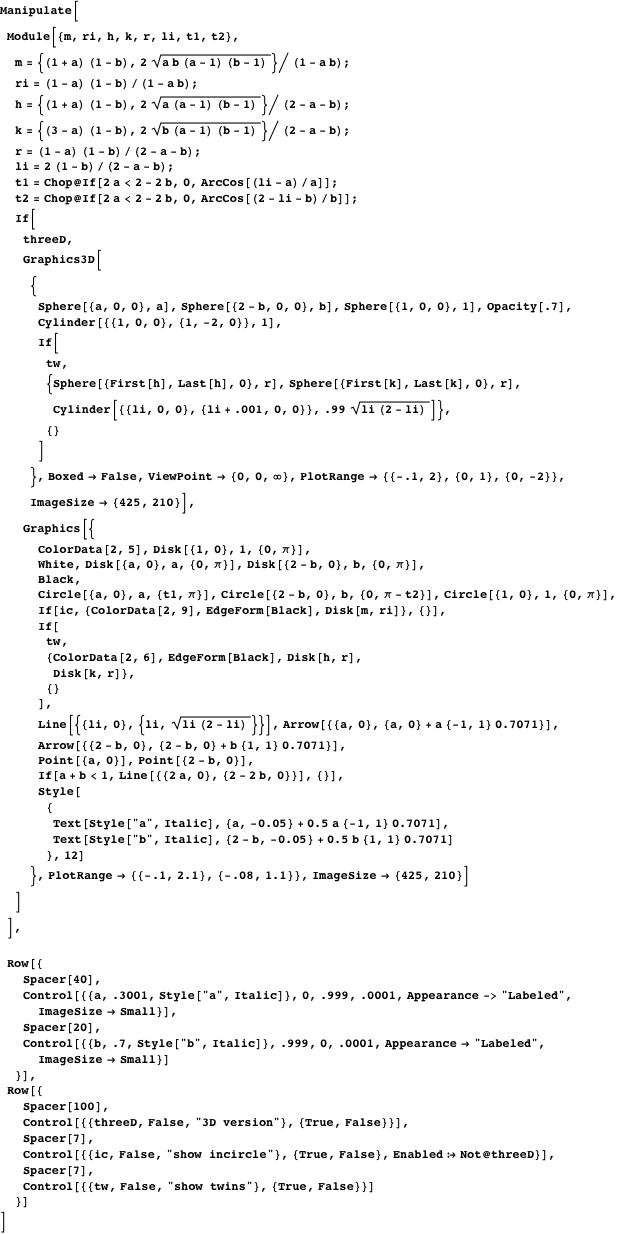
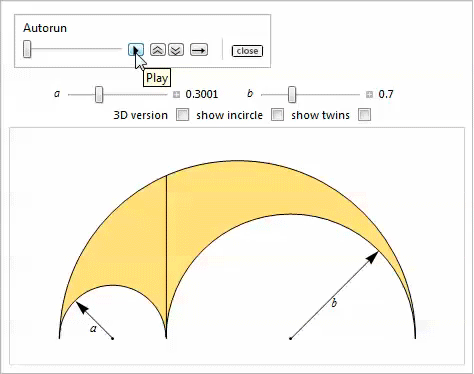
28
, .
Let be
5
,
, ,


, , .
, . , , , [24,25].
Manipulate .


Manipulate .

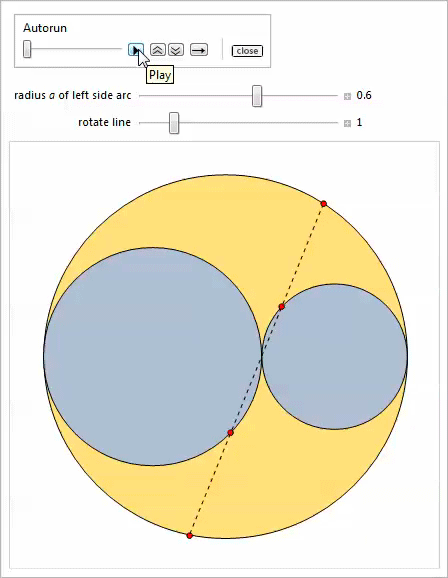
, Manipulate .
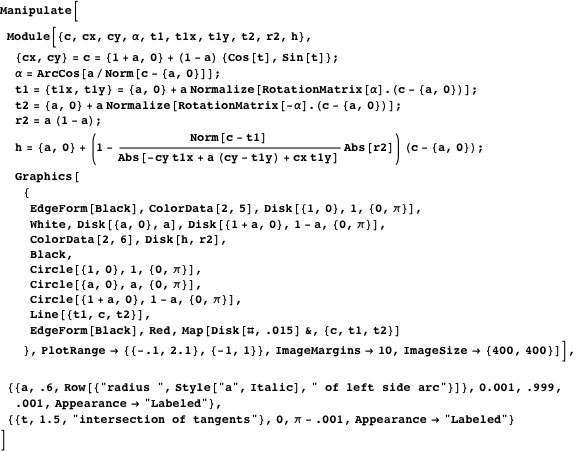

Bibliography
[1] F. van Lamoen. “Online Catalogue of Archimedean Circles.” (Jan 22, 2014) home.planet.nl/~lamoen/wiskunde/arbelos/Catalogue.htm .
[2] S. Garcia Diethelm. “Planar Stress Rotation” from the Wolfram Demonstrations Project—A Wolfram Web Resource. demonstrations.wolfram.com/PlanarStressRotation .
[3] CW Dodge, T. Schoch, PY Woo, and P. Yiu, “Those Ubiquitous Archimedean Circles,” Mathematica l Magazine, 72 (3), 1999 pp. 202-213. www.jstor.org/stable/2690883 .
[4] HP Boas, “Reflection on the Arbelos,” American Mathematical Monthly , 113 (3), 2006 pp. 236-249.
[5] HD Dörrie, 100 Great Problems of Elementary Mathematics: Their History and Solution (D. Antin, trans.), New York: Dover Publications, 1965.
[6] J. Rangel-Mondragón. “Recursive Exercises II: A Paradox” from the Wolfram Demonstrations Project—A Wolfram Web Resource. demonstrations.wolfram.com/RecursiveExercisesIIAParadox .
[7] RB Nelsen, “Proof without Words: The Area of an Arbelos,” Mathematics Magazine , 75 (2), 2002 p. 144.
[8] A. Gadalla. “Area of the Arbelos” from the Wolfram Demonstrations Project—A Wolfram Web Resource. demonstrations.wolfram.com/AreaOfTheArbelos .
[9] J. Rangel-Mondragón, “Selected Themes in Computational Non-Euclidean Geometry. Part 1. Basic Properties of Inversive Geometry,” The Mathematica Journal , 2013 . www.mathematica-journal.com/2013/07/selected-themes-in-computational-non-euclidean-geometry-part-1 .
[10] D. Pedoe, Geometry: A Comprehensive Course , New York: Dover, 1970.
[11] M. Schreiber. “Orthogonal Circle Inversion” from the Wolfram Demonstrations Project—A Wolfram Web Resource. demonstrations.wolfram.com/OrthogonalCircleInversion .
[12] MG Welch, “The Arbelos,” Master's thesis, Department of Mathematics, University of Kansas, 1949.
[13] L. Bankoff, “The Marvelous Arbelos,” The Lighter Side of Mathematics (RK Guy and RE Woodrow, eds.), Washington, DC: Mathematical Association of America, 1994.
[14] GL Alexanderson, “A Conversation with Leon Bankoff,” The College Mathematics Journal , 23 (2),1992 pp. 98-117.
[15] S. Kabai. “Tangent Circle and Arbelos” from the Wolfram Demonstrations Project—A Wolfram Web Resource. demonstrations.wolfram.com/TangentCircleAndArbelos .
[16] G. Markowsky and C. Wolfram. “Theorem of the Owl's Eyes” from the Wolfram Demonstrations Project—A Wolfram Web Resource. demonstrations.wolfram.com/TheoremOfTheOwlsEyes .
[17] PY Woo, “Simple Constructions of the Incircle of an Arbelos,” Forum Geometricorum , 1 , 2001 pp. 133-136. forumgeom.fau.edu/FG2001volume1/FG200119.pdf .
[18] B. Alpert. “Archimedes' Twin Circles in an Arbelos” from the Wolfram Demonstrations Project—A Wolfram Web Resource. demonstrations.wolfram.com/ArchimedesTwinCirclesInAnArbelos .
[19] J. Rangel-Mondragón. “Twins of Arbelos and Circles of a Triangle” from the Wolfram Demonstrations Project—A Wolfram Web Resource. demonstrations.wolfram.com/TwinsOfArbelosAndCirclesOfATriangle .
[20] H. Okumura, “More on Twin Circles of the Skewed Arbelos,” Forum Geometricorum , 11 , 2011 pp. 139-144. forumgeom.fau.edu/FG2011volume11/FG201114.pdf .
[21] EW Weisstein. “Point-Line Distance—2-Dimensional” from Wolfram MathWorld —A Wolfram Web Resource. mathworld.wolfram.com/Point-LineDistance2-Dimensional.html .
[22] L. Bankoff, “Are the Twin Circles of Archimedes Really Twins?,” Mathematics Magazine , 47 (4), 1974 pp. 214-218.
[23] F. Power, “Some More Archimedean Circles in the Arbelos,” Forum Geometricorum , 5 , 2005 pp. 133-134. forumgeom.fau.edu/FG2005volume5/FG200517.pdf .
[24] AV Akopyan, Geometry in Figures , CreateSpace Independent Publishing Platform, 2011.
[25] H. Okumura and M. Watanabe, “Characterizations of an Infinite Set of Archimedean Circles,” Forum Geometricorum , 7 , 2007 pp. 121-123. forumgeom.fau.edu/FG2007volume7/FG200716.pdf .
Source: https://habr.com/ru/post/257319/
All Articles